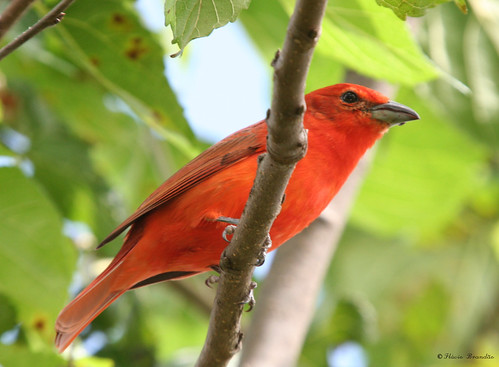The Hepatic Tanager, Piranga flava, is a medium-sized American songbird. Its genus, Piranga, was traditionally placed in the tanager family (Thraupidae) but some now place it in the cardinal family (Cardinalidae).
The habits of the Hepatic Tanager are similar to those of the Western Tanager.
It ranges from the southwestern United States (Arizona, New Mexico, and locally in southern California and Colorado) to northern Argentina. There are three subspecies groups, which may be separate species: hepatica, breeding from Nicaragua north in pine and pine-oak forests and partially migratory; lutea, resident from Costa Rica to northern and western South America in highland forest edges; and flava, resident in open woods elsewhere in South America.
The northern form is larger and stockier than other Piranga tanagers and has a relatively short tail and a stout bill. Its brightest color is always on its forehead and throat. In all plumages, it has grey flanks, dusky cheeks, and a dark eye streak. The female is yellow, and the male is red. Its average weight is 1.3 oz (38 g). Its average wingspan is 12.5 in (31.8 cm) and length 8 inches (20.3 cm).
Its call is a low, dry chup like the Hermit Thrush. Its song is clearer than Thraupidae tanagers and far more similar to the song of the Black-headed Grosbeak, another member of the Cardinalidae. The flight call is a husky and rising weet.
It looks for food in the foliage of trees, moving slowly and methodically; different individuals use different strategies. In summer, the northern form eats largely insects and spiders, with some fruit. In Mexico it has been observed to eat nectar. From Oaxaca south it follows swarms of army ants.
Even the northern population's behavior and life history are remarkably little known.
The habits of the Hepatic Tanager are similar to those of the Western Tanager.
It ranges from the southwestern United States (Arizona, New Mexico, and locally in southern California and Colorado) to northern Argentina. There are three subspecies groups, which may be separate species: hepatica, breeding from Nicaragua north in pine and pine-oak forests and partially migratory; lutea, resident from Costa Rica to northern and western South America in highland forest edges; and flava, resident in open woods elsewhere in South America.
The northern form is larger and stockier than other Piranga tanagers and has a relatively short tail and a stout bill. Its brightest color is always on its forehead and throat. In all plumages, it has grey flanks, dusky cheeks, and a dark eye streak. The female is yellow, and the male is red. Its average weight is 1.3 oz (38 g). Its average wingspan is 12.5 in (31.8 cm) and length 8 inches (20.3 cm).
Its call is a low, dry chup like the Hermit Thrush. Its song is clearer than Thraupidae tanagers and far more similar to the song of the Black-headed Grosbeak, another member of the Cardinalidae. The flight call is a husky and rising weet.
It looks for food in the foliage of trees, moving slowly and methodically; different individuals use different strategies. In summer, the northern form eats largely insects and spiders, with some fruit. In Mexico it has been observed to eat nectar. From Oaxaca south it follows swarms of army ants.
Even the northern population's behavior and life history are remarkably little known.




No comments:
Post a Comment